

Transcriber’s Note: This text was handwritten originally with many illustrations containing captions that were also handwritten. We have tried to represent the original as faithfully as possible which means that some sentences begin with lowercase letters, some sentences run on, inconsistent spelling is prevalent, etc. The HTML version contains the images of the original pages with transcriptions underneath.



To
The Courteous Reader.
Greeting
The stream of Conquest has generally flowed from North to South. The Triumph progress of the Goddess Nicotina has been from West to East starting in the 16th. century she has now girdled our little orb with devotees burning continuous incense. The Instruments connected herewith are objects of Historical & Ethnographical interest hence are brought together authentic Portraits of the “Pipe Family”. Briar root and Branch “who judge from the favor in which they are now held.” “At home & abroad” they seem likely to flourish for ever. I cannot close without expressing my thanks to Mr. Bernard Quaritels for placing then before you in their present Garb.
Your faithful Sinner & Author,
Robt. Pritchett.
A·D·
1890

| Page | |
| 9 | Tobacco Plant 1669 ·A·D |
| 11 | “NICOTIANA” flower. |
| 13 | German Woodcut 1616. AD. |
| 15 | Rich old Clays. |
| 17 | Broseley Clays. |
| 19 | Churchwardens. |
| 21 | Dutch Pipe Gear. |
| 23 | German Pipes. |
| 25 | Danish & N. Europe. |
| 27 | Algeria. |
| 29 | W. Africa. |
| 31 | Lagos & Ashantee. |
| 33 | Dahomy & Niger. |
| 35 | Wild Hemp smoking |
| 37 | Equatoria. |
| 39 | Stanley Expedn. |
| 41 | East Africa. |
| 43 | Bushmen. |
| 45 | Soap Stone Pipes. |
| 47 | Turkey. |
| 49 | Persian. 1669. A·D |
| 51 | Hookah. India. |
| 53 | Hookah. Cashmere. |
| 55 | Indian Red clay. |
| 57 | Scinde. |
| 59 | Madras. [7] |
| 61 | Narghile. Indore. |
| 63 | Yarkand. Asia. |
| 65 | Gourd Pipe. |
| 67 | Assam & Burmah. |
| 69 | China & Corea. |
| 71 | Opium Gear. |
| 73 | Japanese ditto |
| 75 | Borneo. |
| 77 | Sumatra & Java |
| 79 | Australia. |
| 81 | New Zealand. |
| 83 | New Guinea. |
| 85 | S. America. |
| 87 | N. America. |
| 89 | N. AMER. Stone Pipes |
| 91 | Canada. |
| 93 | Nootka Sound. |
| 95 | Arctic Pipes. |
| IGNITION. | |
| 97 | Sumatra & Borneo. |
| 99 | S. America. |
| 101 | England old & New. |


Although Smoking is generally associated with Tobacco only, yet there are other plants whose leaves are used for similar purposes & these will be referred to as we come to the different means of using them. Our first Woodcut of Tobacco is from STELLA—ROMA 1669. a work of


great value as giving Pipes & the Hookah of Persia as well as Plants but we will start with some of the growths now most generally known of the “NICOTIANA” Family which is very widely spread over the face of the Earth & has of late made great strides in Borneo & Sumatra.
NICOTIANA “TABACUM”. (The mother of the family) Height 5 ft. Leaf 12in to 14in. Corolla Pink. Virginia manilla.
N. “RUSTICA”. Height 3 to 4 ft. Leaf 10in. to 12in. Corolla Greenish into Yellow. Turkey & India.
N. “REPANDA”. Small. Corolla white. Havannah.
N. “PERSICA”.—or Bombay, all used in Persia by the Royal Family. (SHIRAZ tobacco).
N. “AFFINIS” is our Garden Plant with long tube 3½in. with Corolla White. Very fragrant. Habitat. Isle of Pines. S. PACIFIC.


We are greatly indebted to old German woodcuts for solid information anent details of Habits & customs of the 16th. Century which our own people have not handed down to us, take for instance “Hans Sachs.” Book of Trades. Had smoking been in vogue in his day he would have given it—or rather Jost Ammon would have illustrated it so here in 1616 ·A·D we find a Sturdy German, blowing a tremendous cloud. It is taken from an old work now in Frankfurt—viz
“Völler Von Gellhausen (ULRICUS).”
Das ist
“Ein. Blumenbuck.”
Small Folio.
Franckfurt
am Mayne.
M. Weixner. Formscheider und Mahler. A·D 1616.


We have heard much of late of The “STONE” Period. The “Bronze” Period & the “Iron” Period & some one has gone so far as to say this is the “Brass Tin” Period. on all these scores “SMOKIANA” is strongly represented bringing forward The “Brass” Pipes of SUMATRA. It is surprising how widely diffused is “STONE” especially “Soap stone.” Amongst the following specimens will be found our “Gourd.” Period—but as there is “no place like Home” we will begin with “English clays,” of which some are shown on the opposite page enriched by Tobacco of recent years..


The various stamps & names of early makers of Tobacco Pipes are most satisfactorily corroborated by the Parish Register and the families seem to have gone on prospering, but the sickle “of Old Time” has been put in & . & old things have passed away making room for new. The Four stamps given on the opposite Page are amongst the Earliest known. & of great interest. The quality of the Clay must have attracted the makers to that spot—after the introduction of Pipes to London, which had a Pipe maker’s Company .A·D. 1619 & still continues establishments at Bow.. The “Old Cock” Tavern in Fleet Street had its own Token & its own Pipe.


and old London as revealed in digging old foundations has yielded a great harvest of Pipe produce.. The museum at Guildhall has a very good collection. The “Churchwarden” Clay was the Pipe of the early part of this century & is still in the Country. It was considered right always to have a clean pipe hence they were stacked together in a double ring & sent to “The Bake-house” for Purification. The “Irish Dudean” originated the rich “old clay” most probably & the Scotch followed with Cutties, & The French with “Fiolets” bien “Cullottées”—of Forty years ago. “Milo” in the Strand was the man for “Colouring Clays” which he made his Specialty.


The Dutch have always been great Smokers, how often does Ostade introduce clay Pipes into his pictures & when they favored us with a visit in 1689. how many records have been dug up from time to time wherever they were located. The Typical Pipe of Holland is that of “GOUDA” make. & The Pipe enters largely into Wedding ceremonies thus they have for the Copper wedding, the long clay Pipe of some 36in. decorated with Copper leaves. The Silver Wedding Silver leaves & The Golden Wedding Gold & finally The Diamond—for the 75th. now Cigars are smoked by every one, even by little Hollanders going to school
9·A·M·


As a Nation of Smokers The Germans have always carried the palm & do still & with them Smoke & Song were ever inseparable. Imagine a German Student without his Pipe, & his Corps Cap we should not know him. The Leading feature in German Pipes is decidedly The long Bowl of Porcelain generally adorned with some Beauty on the front of it in medallion form. The stems are of great lengths some four feet or so with flexible tubing leading up to the mouth piece. These may be considered House Pipes for travelling, naturally they are shorter. The Tobacco Bags are objects of great care & interest.


The Island of “AMAGER” near Copenhagen has retained its costumes & customs so faithfully that we have confidence in the Pattern Pipes which are now still in use. The Long one. 4 ft 8 in is the House, the shorter one 6in. in the bowl contains the allowance of Tobacco for the day, this is the constant companion of the out-door worker.
In Norway small blocks of meerschaum seem to be most in vogue.
The Hungarian Pipes are of red clay. & show asiastic influence in form.
The Tyrolese Pipes look very workman like mostly of wood with Roebuck horn—introduced as ornament—


We are now in a new sphere of Pipe-Land: a Kind of slack water between European & Asiatic systems—in which the Turkish type predominates thus the upper Red clay bowl on the opposite page is quite Turkish & the handsome Arab Pipe of a form seen often smoked riding on a Camel shews us how decoration will now be introduced in a new form. The Stem of this Pipe is beautiful in Colour, the Ivory having a very beautiful arabesque pattern upon it, the red colour of which harmonises delightfully with the dark wood & bowl. The Large bowl is decidedly for House or Tent service.


Everywhere in the Dark Continent the habit of smoking something or somehow has been met with by our most energetic explorers even in the dense forests of new Equatoria. The Pigmies find it desirable to have something to smoke. Paul Du Chaillu in 1856 brought to our notice the Pipes shewn at the top of the next page. These are used by The Fans, a fierce Cannibal tribe—great in the mystery of Iron work, and are generally made of red or very dark clay. The Specimen from SANKURU River LAT 5° S is of wood & very beautifully carved.—The Bone Pipe is very like a Cigar Holder


The Three Bowls of the dark clay bowl are certainly a striking object to any smoker.. and again the small bowl from the larger one in fact “Bowl major.” “Bowl Minor”—this plurality we shall find in India, still that does not very clearly explain the why & wherefore—unless it emanates from mere love of being unlike others.. The Light coloured Red Clay of the Ashantee Pipes is very striking—& the form of the Bowls still more so. There is a decidedly Classical character about them.. as if started from Roman Lamps & Pompeian ideas & then supplied to their Colonies—.


DAHOMEY is associated in our minds with the most ghastly & cruel scenes of useless blood-shed. & yet “TOBACCO” is smoked there and gradually is the Symbol of Peace asserting its gentle influence & Dahomey is now more humane than when Capt. Burton first visited it. To him we are indebted for the specimens opposite. The long peculiarly formed bowl like a “nepenthes” or Pitcher Plant is of Iron & has prongs or spurs of Iron. Length of stem, 33 in. The Hanging tufts are of Red Indian character. The upper pipe is carved wood & the double one, Iron.


We now come to newly opened up country, for Livingstone is of our time & Bishop MacKenzie in the Zambesi river also: The wooden Pipe with the Curious board in front of the Bowl is used by the LOMWE Tribe of MAKUAS on the LUKUGU River which runs into the “LAKE TANGANYIKA”—W. and a very curious arrangement it is the front of the board being elaborately carved. The Two lower Pipes are large & cumbersome & used to smoke Wild Hemp or “Cannabis Indica” sometimes called Banghi, but generally, “Bang”—In India we find the same name applied to a spirit obtained from Palms into pots & collected in the Deccan.


The recent explorations in Africa have developed our Geographical Knowledge so much that a very special interest is imparted to many of these specimens by giving carefully the situations from which they have been procured—thus. The Ivory pipe of King MTESA from UGANDA Victoria nyanza is from a new Country & the ornamentation very refined & delicate. next the long one 8 ft. presented by the Khedive to the British Museum is from the MONBUTTOO tribe N. W. of the ALBERT NYANZA. The Lower one is from the SHIRÉ River near the Murchison Falls & used for Wild Hemp by the Manganja people.


For this most interesting page we are indebted to Surgeon Parke who very kindly took the trouble to make sketches of the bowls & wrote the names under each. what better authority could we have than this.. it makes the page historically interesting. The hard clay of the sticky ant heaps takes a beautiful polish see the KAVALLI bowl Albert NYANZA. The most original is from AREWENI & ITURI Forest where the little people take the mid rib of the “Banana” which is cellular & by pushing a reed down they get the bore required, cut a hole & rolling up a piece of Banana leaf.. like a Grocer’s paper insert that for a Bowl & smoke.


Zanzibar at the present moment is a centre of public interest and the example given on the next page is an exceedingly good one, it is of carved wood & has much of the ARAB character in its form. The Large one is of wood also with good ornamentation, the Bowl is 4in. in diam and the total length 12in. this is used for smoking Wild Hemp or Bang—and sometimes known as. “LIAMBA.”—it is from NYASSA. LAT 9° S. LONG. 31.E. This is a pipe of mixed features as the arrangement is strongly allied to the Bushmen on the next page. it is however from N. W of Victoria nyanza UGANDA · NYASSA LAND. The Bowl is of dark clay with a gourd body. HABITAT doubtful


Now we arrive at the full swing of the Stone Bowls of Soap stone or “STEATITE” and the link with the last “UGANDA” Pipe will at once be recognised. The whole machine is most cumbersome& the size therefore—The Horn being some 18in. must make it bad for Bushwork. Altho the tube can be unshipped most readily The Stone Bowls are carved with great care, the favorite form reminds us of the maces or “Martel de Fer” used in the real Iron Period.—There is found also the Duplex Bowl also in Steatite.


The “Steatite” Bowls now show decidedly European influence, altho the most striking feature is the under disc which is probably added to give strength as the Steatite itself is very friable, its form reminds one of the inverted comb on the skull of a Gorilla which is very African. These specimens like many others are from that Great Store House of information The British Museum which happily secured many of the interesting examples collected by the late Mr. Bragg F.S.A. We can but regret that so complete a collection should ever have been dispersed—Sic transit.


Turkish tobacco is such a familiar form & so comprehensive in its light varieties that Turkish pipes must at once be called “CHIBOUQUES” & “HOOKAHS”. The red clay bowl of the former is generally 2 in. in diameter. The stem of Cherry or of Iasmine 5 ft long. When the Bowl is primed it is covered with thin paper & prepared for lighting. The Smoker at a range of 5 ft gives the signal & the light is applied—The mouth piece of clouded amber is very rounded & therefore only put to the lips.. The Red clay Hand Hubble of Benares is very simple.


STELLA of ROME, here is again useful to shew us the “Hookah” of Persia in his day. his book was published 1669 and as travelling from TEHERAN to the HOLY CITY was less rapid than nowadays, we may fairly accept this illustration as representing a well-established object. The action of the “Hookah” or “Hubble bubble” is to draw the smoke through the water—& so cool & purify the fumes of the Tobacco Being made of Glass. This is called a “SHISHEH” & in it is smoked the. Persian “TOMBAK” exclusively grown at CHIRAZ is the best & consumed by the Members of the Imperial family.


The Persian Fashion doubtless soon took India by storm & the maharajahs found in Hookahs a new object of luxury & one capable of unbounded decoration, in fact a new field for native talent to embellish & enrich. The upper bowl which contains the tobacco is called
whatever the material whether richly embossed or the simple red clay which tries one’s lips at BENARES. These State Hookahs are of considerable height running to Thirty inches & Three feet—with coils of tubing—which terminates in a silver mouth-piece.


Naturally one would expect to find something of special beauty in the fine collection of The Indian Museum where the art of the various Provinces is so well represented in all kinds of metal work beautiful form & rich Colour. SRINUGGER CASHMERE yields a very lovely specimen of a Hookah. Copper gilt with very rich deep blue and green enamel produces a very noble result of harmonious colour. The “CHILLUM” is a choice work of art & crowns a very fine work of
CASHMERE ART
Height 30 inches.


Of all the dreadful materials ever introduced in any land to the mouth of a smoker. The Red clay of India is certainly the worst & the roughest. Both these examples are Hand Hubble bubbles or HOOKAHS used by the Natives in India and the Red dotted lines shew where the Chillum to carry the tobacco is fitted on.


This is one of the Giants of the Red ware Race is India. 18 inches in height and is used in this north west Province as a Village welcome to travellers & is generally found in the DAK Bungelow. In some parts of India a native may be seen with his Public “Hookah” all alight ready for the passer-by to take a few whiffs—on paying a “consideration” for the privilege & refresher. The lower form was given to the writer by Dr. Watts it is used by the Hill Tribes of “CHITTAGONG”: & was brought over here for the Colonial Exhibition in 1886.
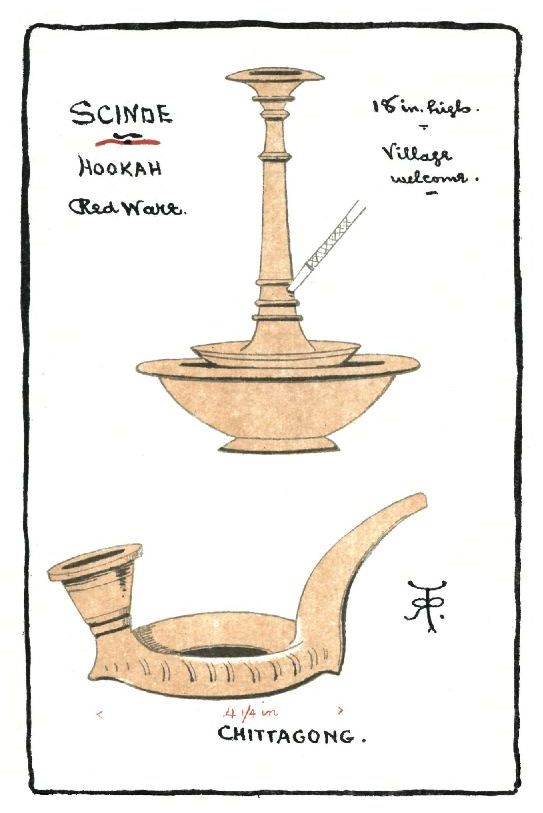

As we are now leaving the “HOOKAH” family & coming to the “NARGHILES” it will be well to emphasize the distinction between the two—which is this—“NARGHILE” is the native term for Cocoanut, hence all smoking mediums of that kind such as must be laid down & will not stand erect are called “NARGHILE”s especially of Cocoanut shape. All “Hookahs” stand by themselves. This bowl from N. ARCOT MADRAS is made of a Bronzed Ware somewhat heavy but good form. The Five topped Chillum is only seen in the Bazaars not in general use.
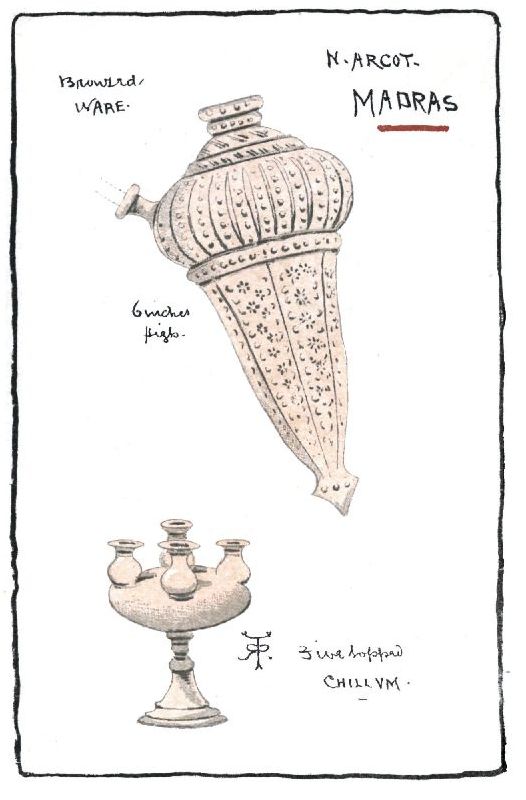
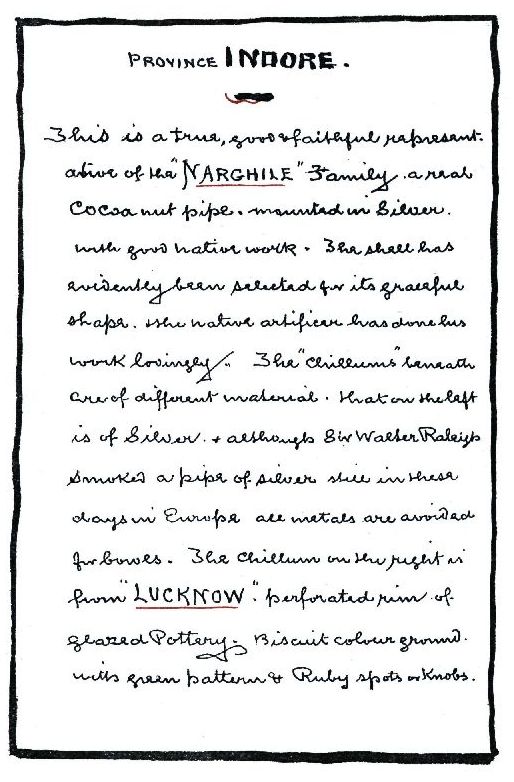
This is a true, good & faithful representative of the “NARGHILE” Family, a real Cocoanut pipe, mounted in Silver with good native work. The shell has evidently been selected for its graceful shape. & the native artificer has done his work lovingly.. The “Chillums” beneath are of different material that on the left is of Silver & although Sir Walter Raleigh smoked a pipe of silver still in these days in Europe all metals are avoided for bowls. The Chillum on the right is from “LUCKNOW” perforated rim of glazed Pottery. Biscuit colour ground with green pattern & Ruby spots or Knobs.
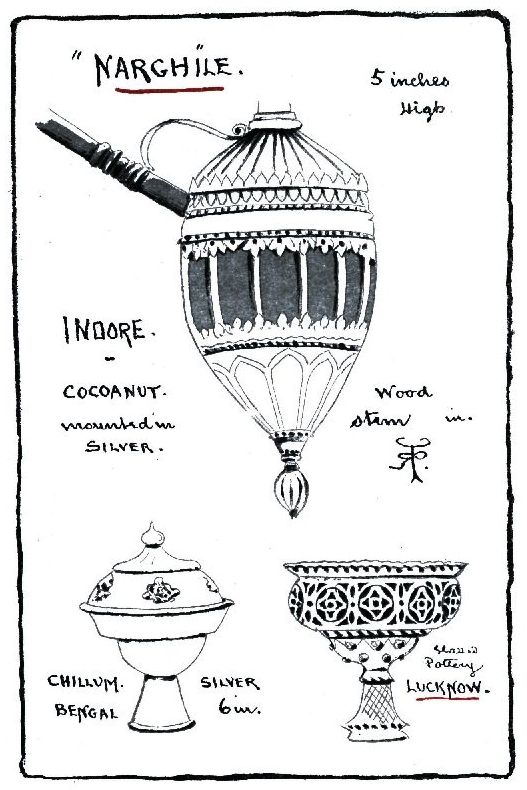
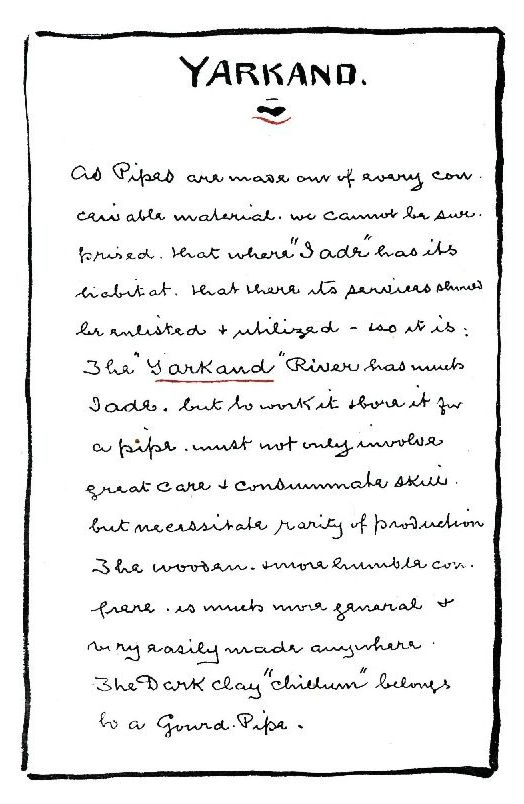
As Pipes are made out of every conceivable material we cannot be surprised that where “Iade” has its habitat that there its services should be enlisted & utilized—& so it is: The “Yarkand” River has much Iade but to work it & bore it for a pipe must not only involve great care & consummate skill, but necessitate rarity of production The wooden & more humble confrere is much more general & very easily made anywhere. The Dark clay “chillum” belongs to a Gourd Pipe.


Having noticed the exceptional Iade we come to the more common Gourd Pipe in fact our “Gourd Period”. They are doubtless received with favor on account of their lightness and the example given is from one in the India Museum where they seem to be of much the same character. The Gourd of about 12 inches in length. The wooden. Bowl carrier curiously turned in rings & the Bowl itself of dark clay The ornamentation is in some cases very elaborate in this case a mixture of Persian & Chinese.
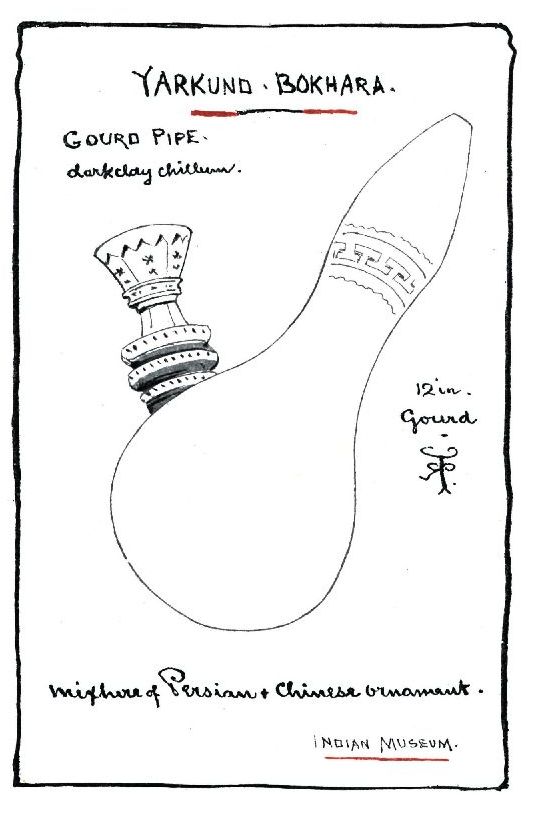
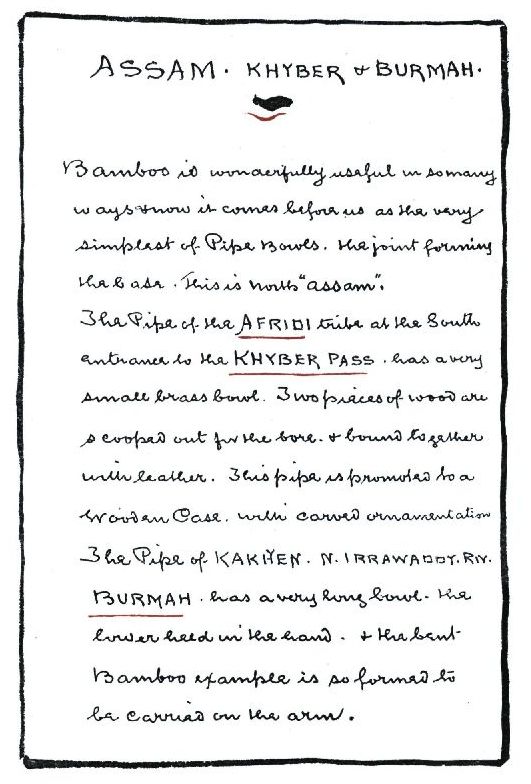
Bamboo is wonderfully useful in so many ways & now it comes before us as the very simplest of Pipe Bowls, the joint forming the base. This is north “Assam.”
The Pipe of the AFRIDI tribe at the South entrance to the KHYBER PASS has a very small brass bowl. Two pieces of wood are scooped out for the bore & bound together with leather. This pipe is promoted to a Wooden Case with carved ornamentation. The Pipe of KAKHYEN N. IRRAWADDY RIV. BURMAH has a very long bowl, the lower held in the hand & the bent Bamboo example is so formed to be carried on the arm.

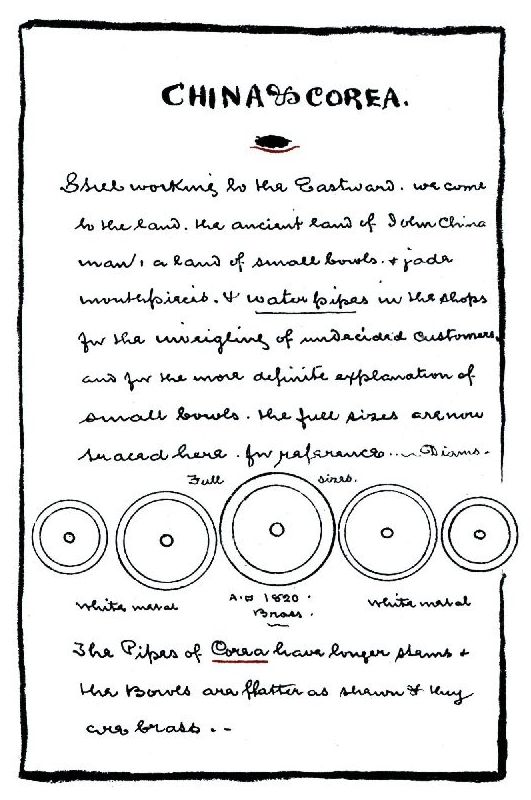
Still working to the Eastward we come to the land the ancient land of Iohn China-man, a land of small bowls & jade mouthpieces & water pipes in the shops for the inveigling of undecided customers and for the more definite explanation of small bowls the full sizes are now traced here for reference..—Diams.
The Pipes of Corea have longer stems & the Bowls are flatter as shewn & they are brass..
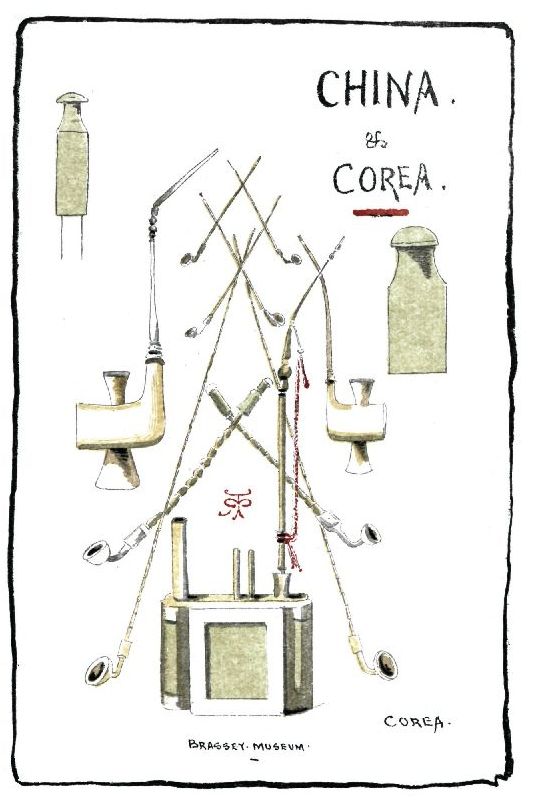
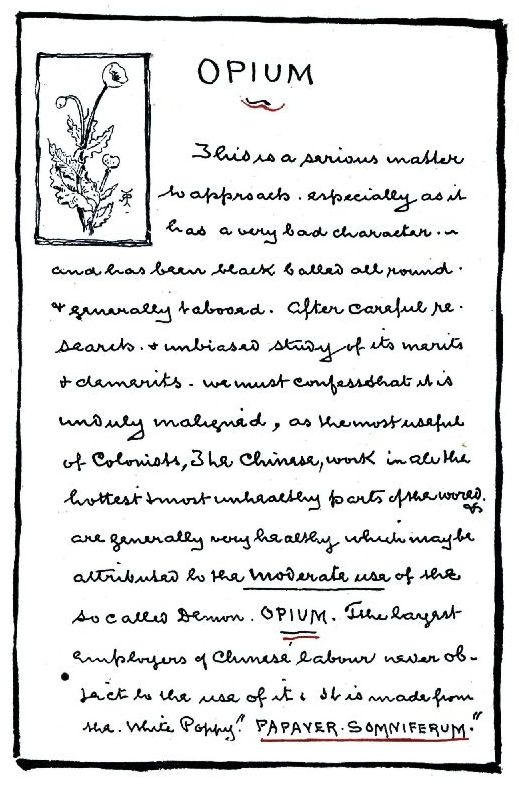
This is a serious matter to approach especially as it has a very bad character—and has been black balled all round & generally tabooed. After careful research & unbiased study of its merits & demerits we must confess that it is unduly maligned, as the most useful of Colonists, The Chinese, work in all the hottest & most unhealthy parts of the world. & are generally very healthy which may be attributed to the moderate use of the so called Demon OPIUM. The largest employers of Chinese labour never object to the use of it & It is made from the White Poppy. “PAPAYER SOMNIFERUM.”
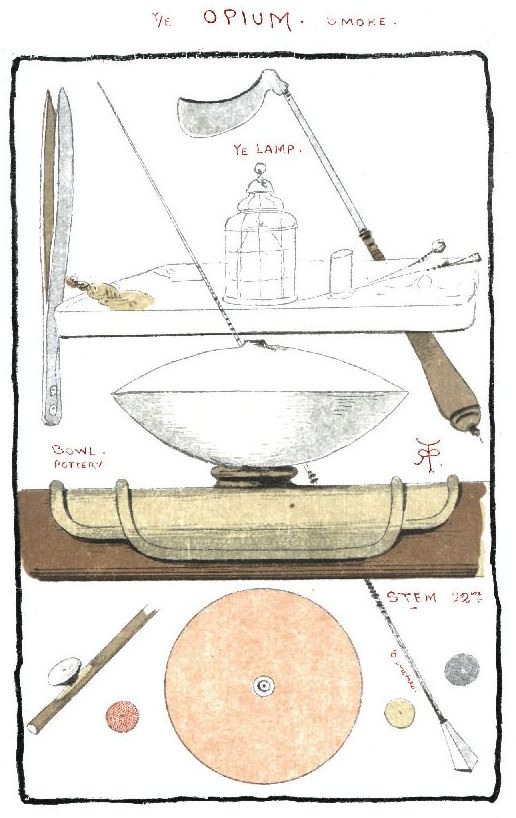
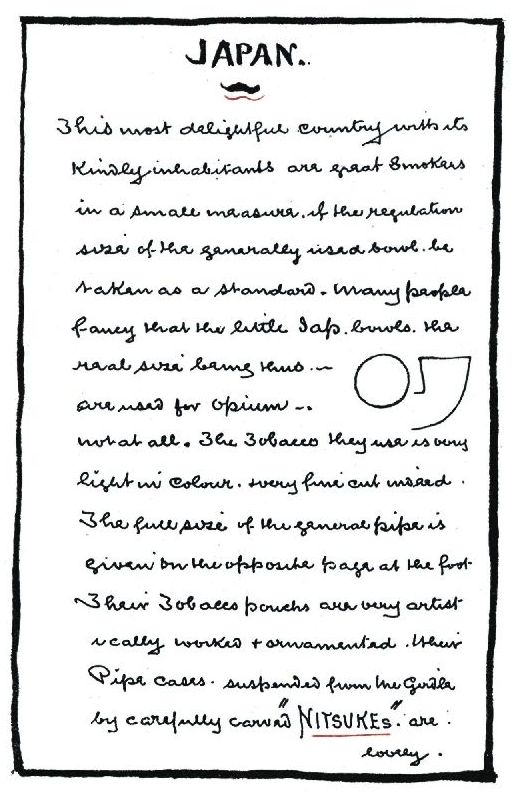
This most delightful country with its kindly inhabitants are great Smokers in a small measure if the regulation size of the generally used bowl be taken as a standard. Many people fancy that the little Jap. bowls the real size being thus.—are used for Opium—not at all. The Tobacco they use is very light in Colour & very fine cut indeed. The full size of the general pipe is given on the opposite page at the foot. Their Tobacco pouchs are very artistically worked & ornamented their Pipe cases suspended from the Girdle by carefully carved “NITSUKES” are lovely.
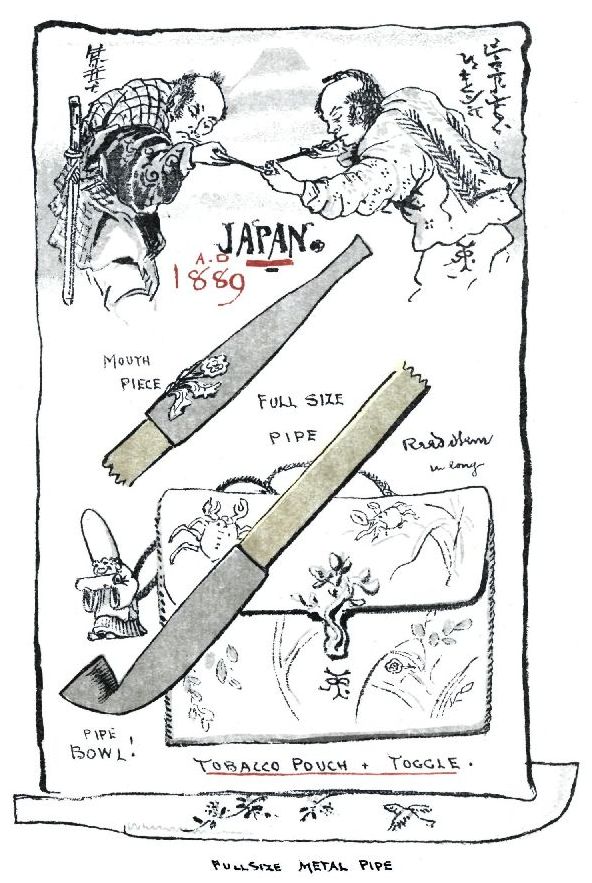
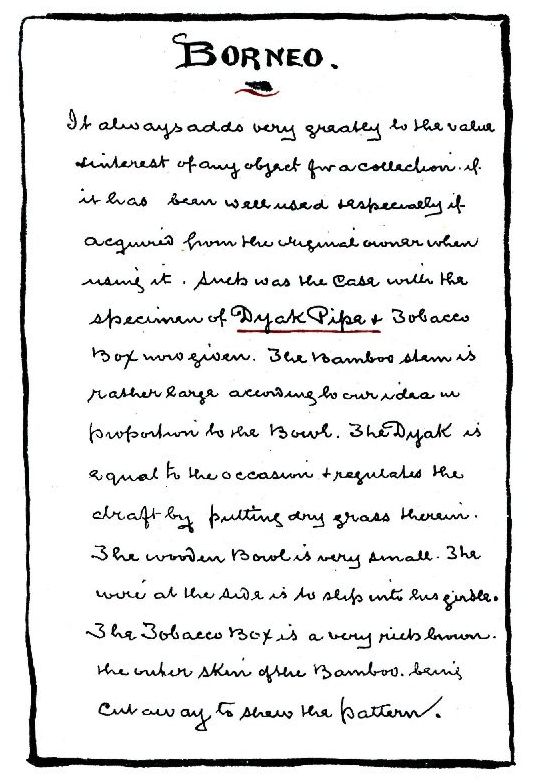
It always adds very greatly to the value & interest of any object for a collection if it has been well used & especially if acquired from the original owner when using it. Such was the Case with the specimen of Dyak Pipe & Tobacco Box now given. The Bamboo stem is rather large according to our idea in proportion to the Bowl. The Dyak is equal to the occasion & regulates the draft by putting dry grass therein. The wooden Bowl is very small. The wire at the side is to slip into his girdle. The Tobacco Box is a very rich brown, the outer skin of the Bamboo being Cut away to shew the pattern.
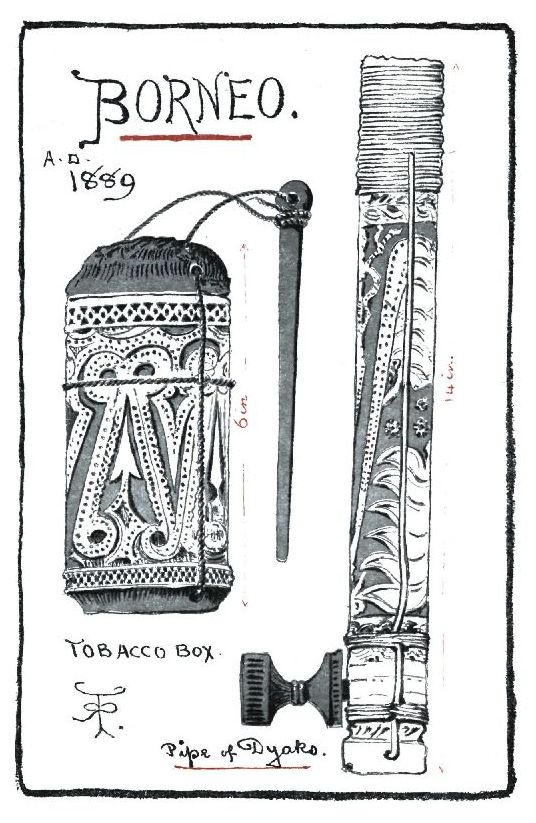
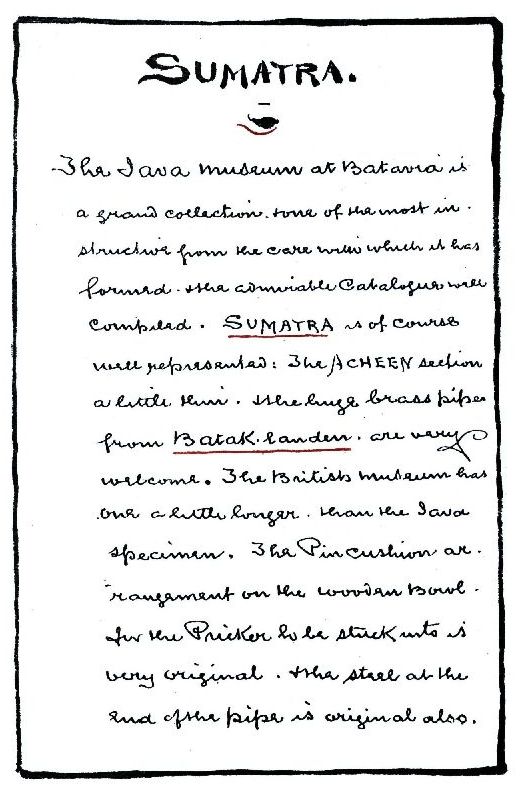
The Iava museum at Batavia is a grand collection & one of the most instructive from the care with which it has formed & the admirable Catalogue well compiled. SUMATRA is of course well represented: The ACHEEN section a little thin. & the large brass pipes from Batak-landen are very welcome. The British Museum has one a little longer than the Iava specimen. The Pin cushion arrangement on the wooden Bowl for the Pricker to be stuck into is very original & the steel at the end of the pipe is original also.
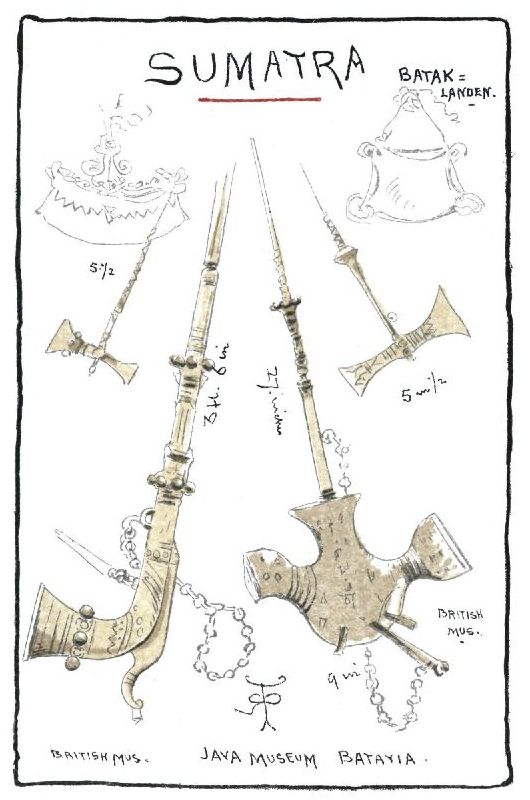
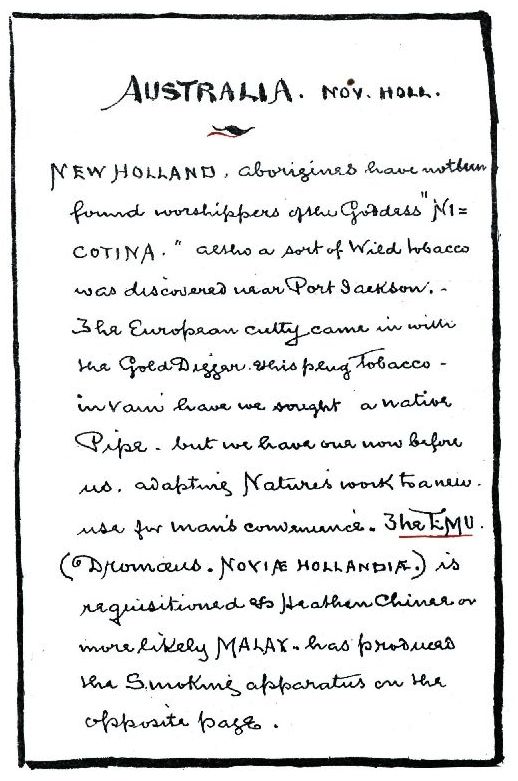
NEW HOLLAND, aborigines have not been found worshippers of the Goddess “NICOTINA” altho a sort of Wild tobacco was discovered near Port Jackson.—The European cutty came in with the Gold Digger & this plug Tobacco—in vain have we sought a native Pipe but we have one now before us adapting Nature’s work to a new use for man’s convenience. The EMU (Dromæus. NOVIÆ HOLLANDIÆ.) is requisitioned & Heathen Chinee or more likely MALAY—has produced the Smoking apparatus on the opposite page.
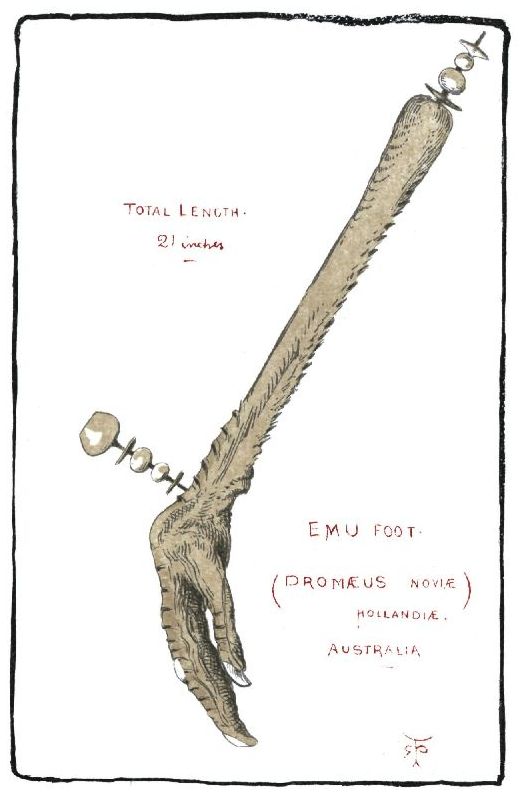
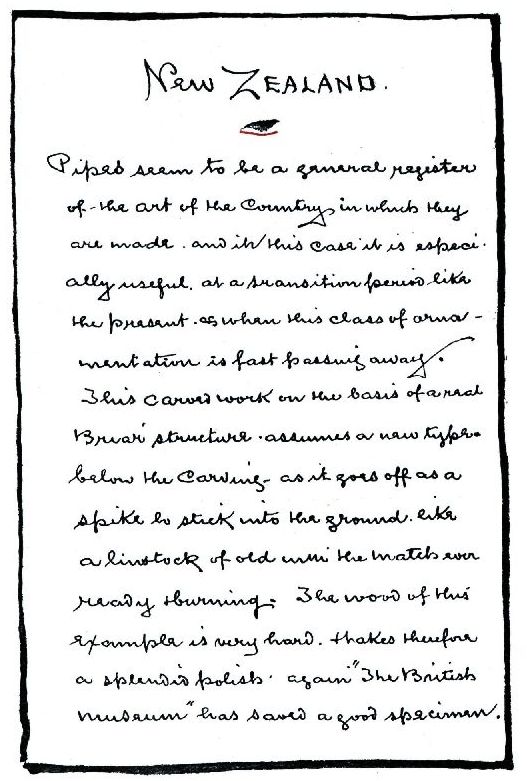
Pipes seem to be a general register of the art of the Country in which they are made and in this case it is especially useful at a transition period like the present as when this class of ornamentation is fast passing away. This carved work on the basis of a real Briar structure assumes a new type—below the carving—as it goes off as a spike to stick into the ground like a linstock of old with the match ever ready & burning. The wood of this example is very hard & takes therefore a splendid polish, again “The British museum” has saved a good specimen.
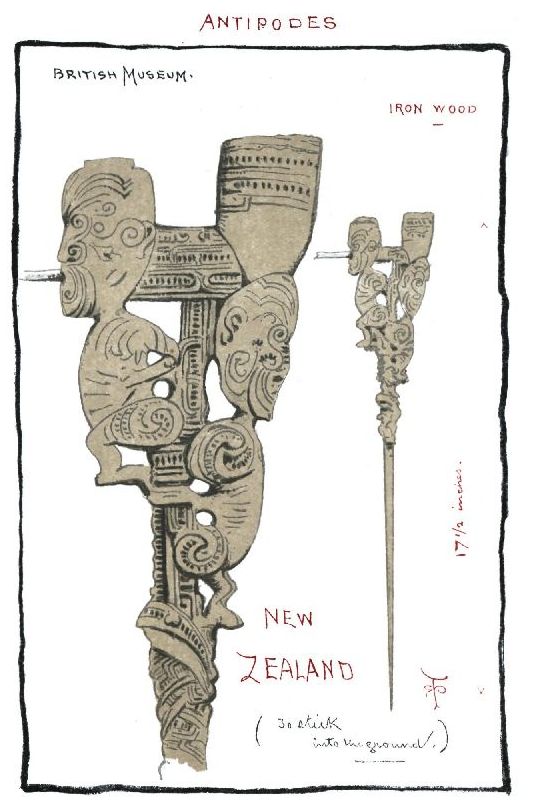
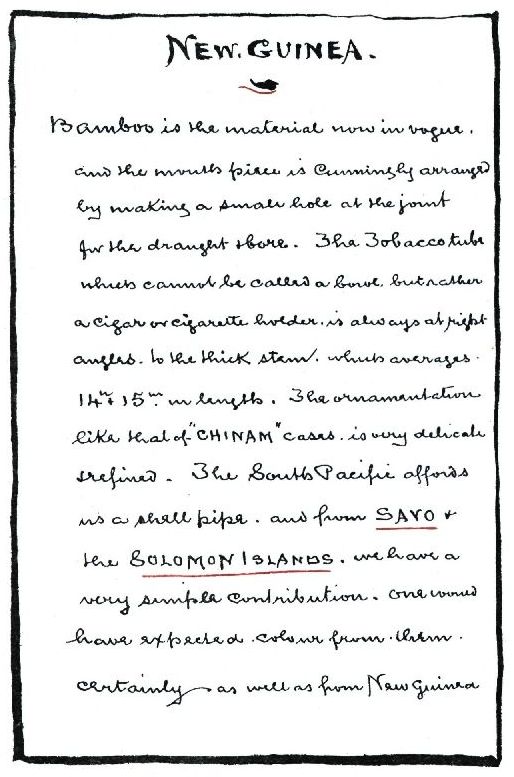
Bamboo is the material now in vogue and the mouth piece is cunningly arranged by making a small hole at the joint for the draught & bore. The Tobacco tube which cannot be called a bowl but rather a cigar or cigarette holder is always at right angles to the thick stem which averages 14in & 15in. in length. The ornamentation like that of “CHINAM” cases is very delicate & refined. The South Pacific affords us a shell pipe and from SAVO & the SOLOMON ISLANDS. we have a very simple contribution one would have expected colour from them certainly as well as from New Guinea
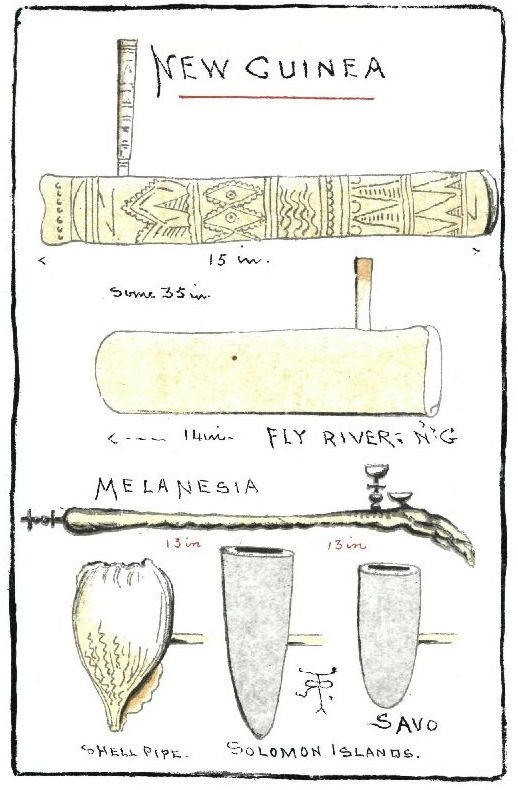
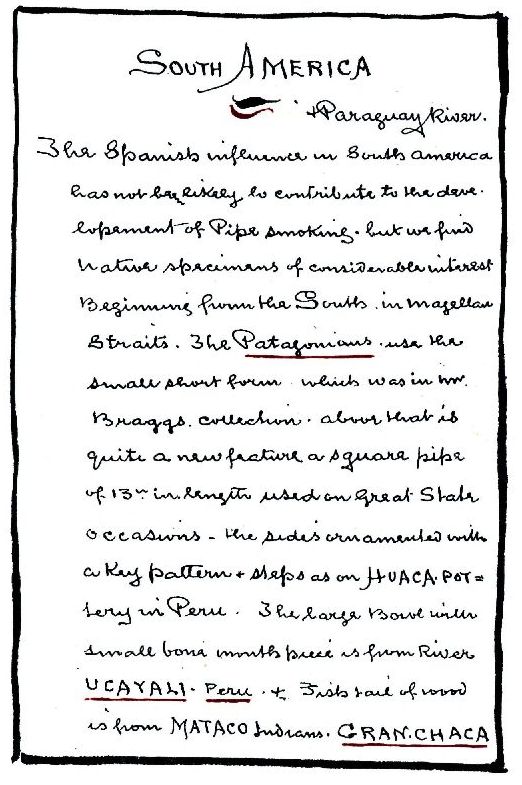
The Spanish influence in South America has not been likely to contribute to the developement of Pipe smoking, but we find native specimens of considerable interest Beginning from the South in Magellan Straits. The Patagonians. use the small short form which was in Mr. Braggs collection above that is quite a new feature a square pipe of 13in. in length used on Great State occasions—the sides ornamented with a Key pattern & steps as on HUACA · POTTERY in Peru. The large Bowl with small bone mouth piece is from River UCAYALI · Peru. & Fish tail of wood is from MATACO Indians. GRAN·CHACA
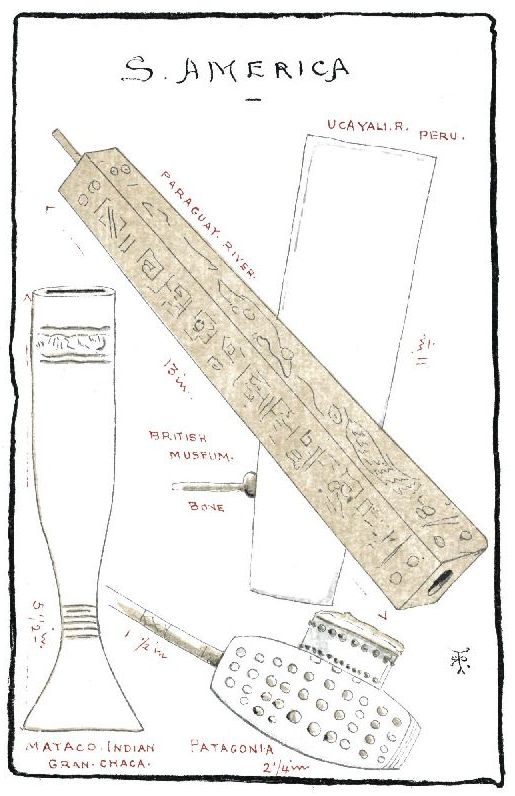
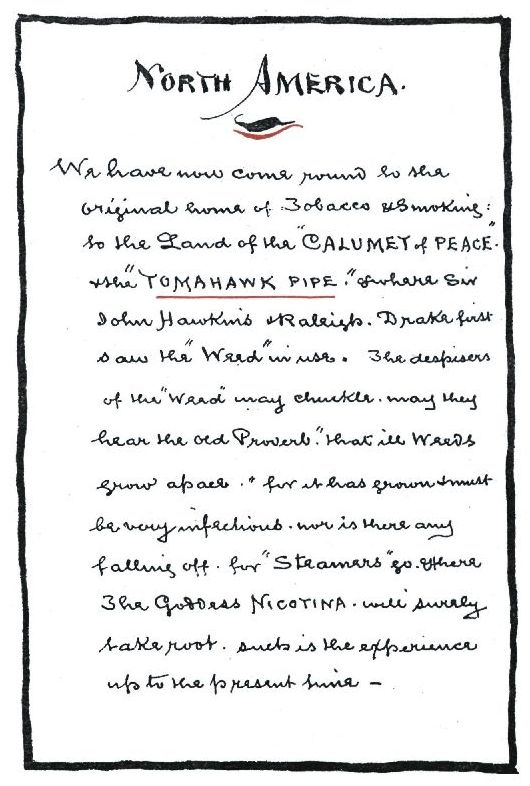
We have now come round to the original home of Tobacco & smoking: to the Land of the “CALUMET of PEACE” & the “TOMAHAWK PIPE” & where Sir Iohn Hawkins & Raleigh. Drake first saw the “Weed” in use. The despisers of the “Weed” may chuckle may they hear the old Proverb “that ill Weeds grow apace” for it has grown & must be very infectious nor is there any falling off for “Steamers” go & there The Goddess NICOTINA will surely take root such is the experience up to the present time—

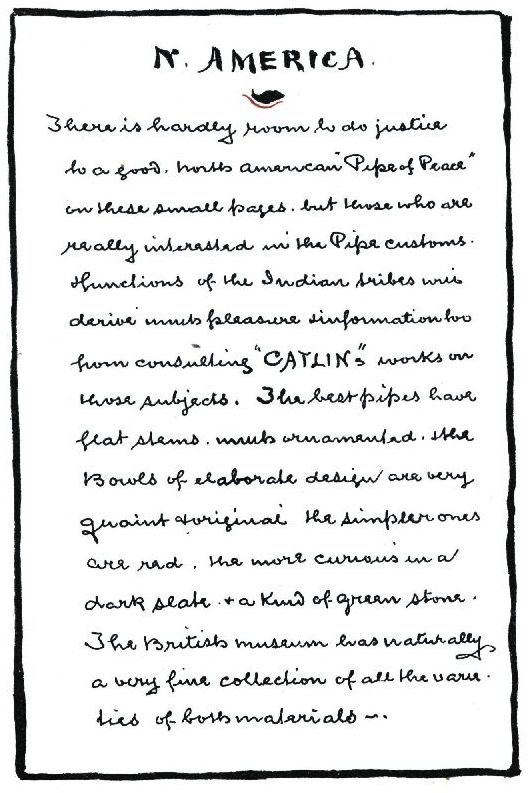
There is hardly room to do justice to a good north American “Pipe of Peace” on these small pages but those who are really interested in the Pipe customs & functions of the Indian tribes will derive much pleasure & information too from consulting “CATLINs” works on those subjects. The best pipes have flat stems much ornamented & the Bowls of elaborate design are very quaint & original the simpler ones are red the more curious in a dark slate & a kind of green stone. The British museum has naturally a very fine collection of all the varieties of both materials—.
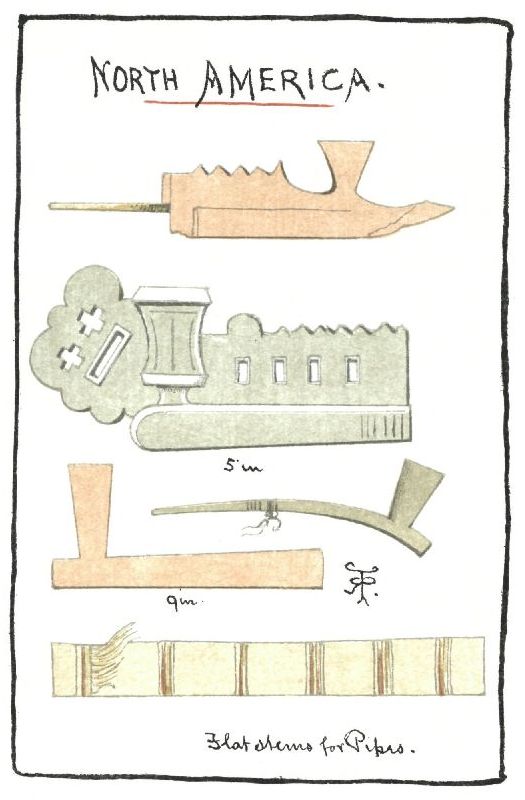
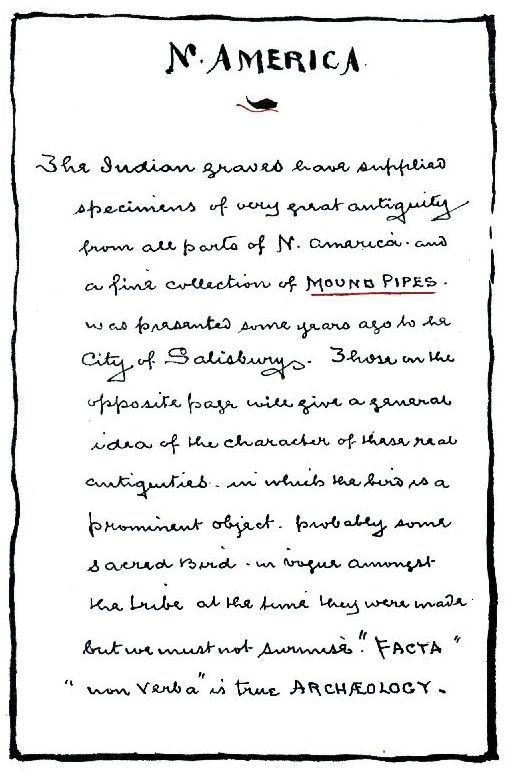
The Indian graves have supplied specimens of very great antiquity from all parts of N. America and a fine collection of MOUND PIPES was presented some years ago to the City of Salisbury. Those on the opposite page will give a general idea of the character of these real antiquities in which the bird is a prominent object probably some sacred Bird—in vogue amongst the tribe at the time they were made but we must not surmise “FACTA” “non Verba” is true ARCHÆOLOGY.
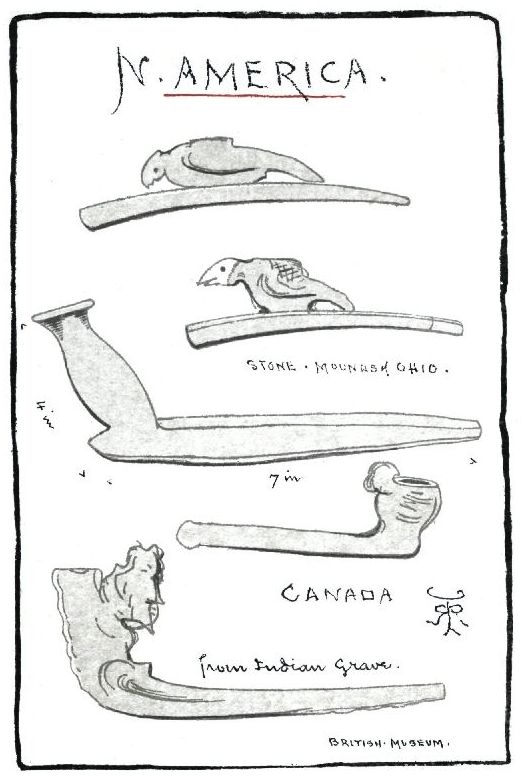
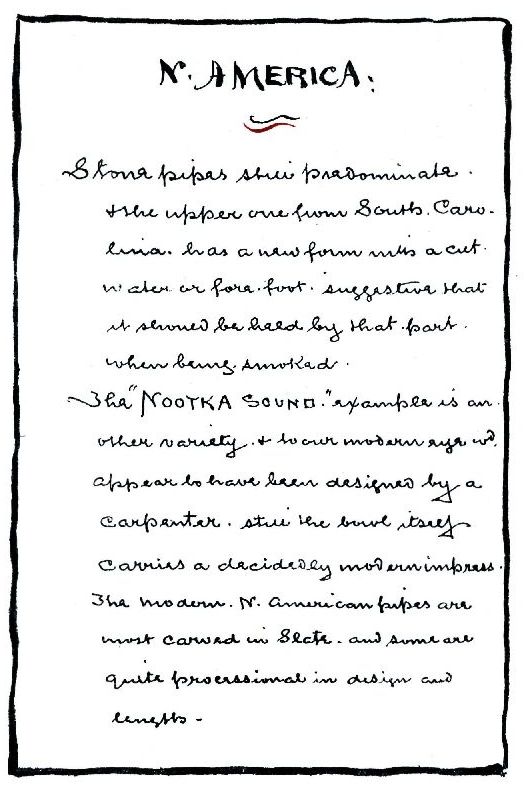
Stone pipes still predominate & the upper one from South Carolina has a new form with a cut-water or fore-foot suggestive that it should be held by that part when being smoked.
The “NOOTKA SOUND” example is another variety & to our modern eye wd. appear to have been designed by a carpenter still the bowl itself carries a decidedly modern impress The modern N. American pipes are most carved in Slate and some are quite processional in design and length.
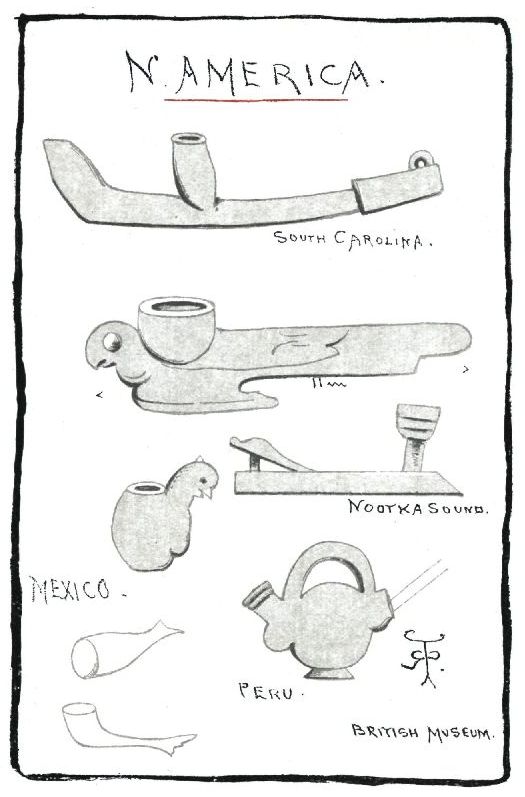
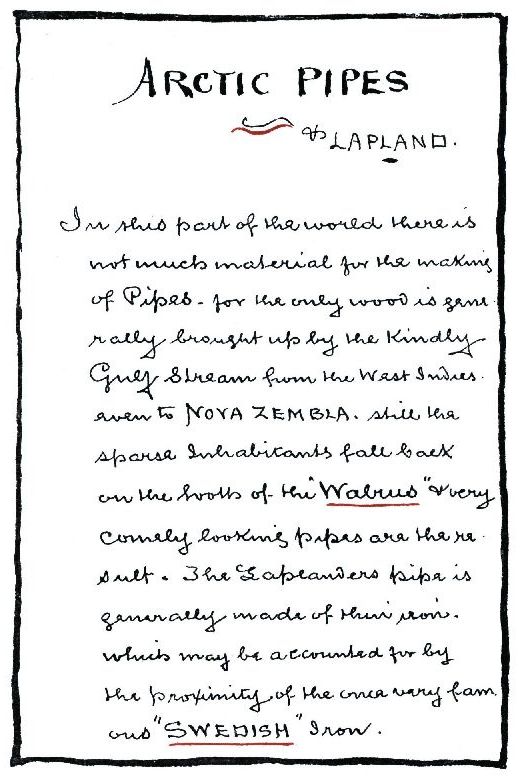
In this part of the world there is not much material for the making of Pipes for the only wood is generally brought up by the kindly Gulf Stream from the West Indies even to NOVA ZEMBLA still the sparse Inhabitants fall back on the tooth of the “Walrus” & very comely looking pipes are the result. The Laplanders pipe is generally made of thin iron which may be accounted for by the proximity of the once very famous “SWEDISH” Iron.
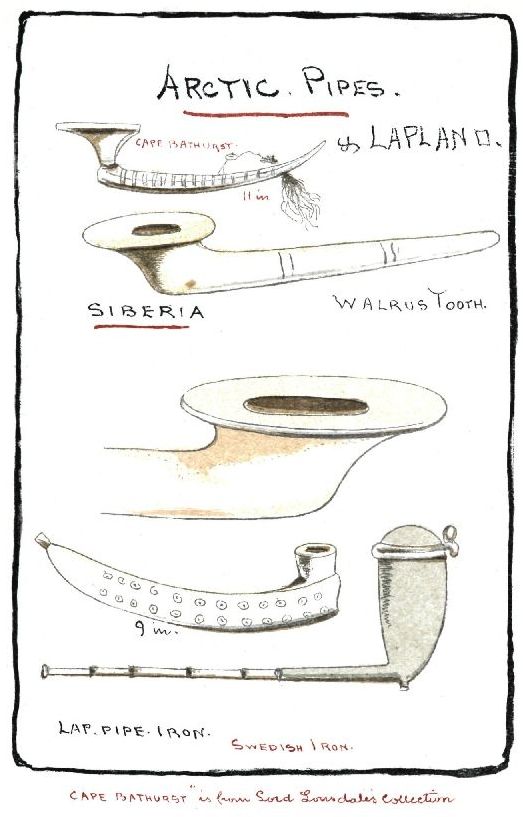
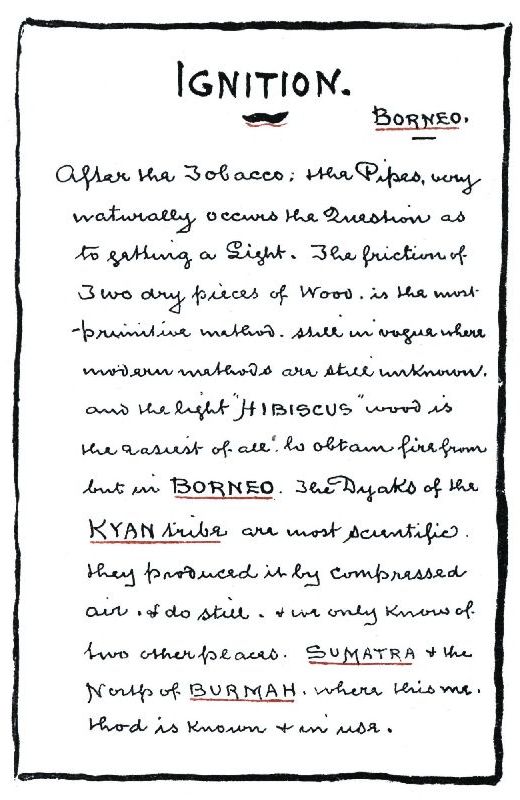
After the Tobacco, & the Pipes, very naturally occurs the Question as to getting a Light. The friction of Two dry pieces of Wood is the most primitive method still in vogue where modern methods are still unknown and the light “HIBISCUS” wood is the easiest of all to obtain fire from but in BORNEO. The Dyaks of the KYAN tribe are most scientific they produced it by compressed air & do still & we only know of two other places SUMATRA & the North of BURMAH where this method is known & in use.
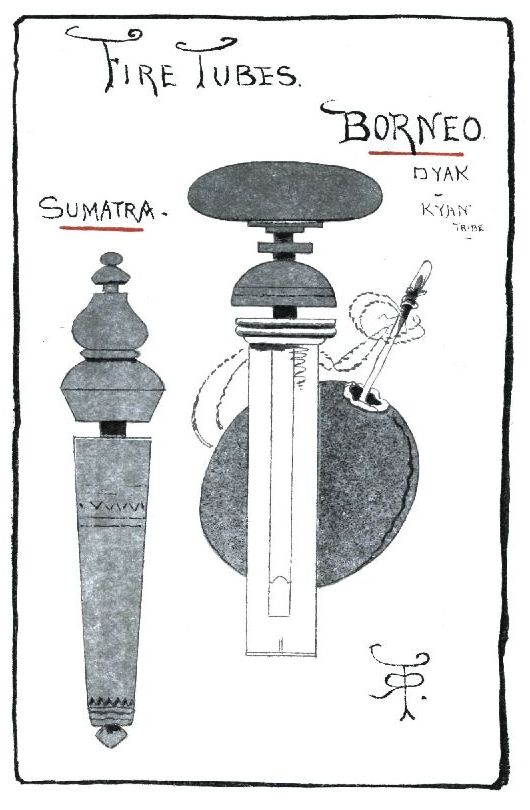
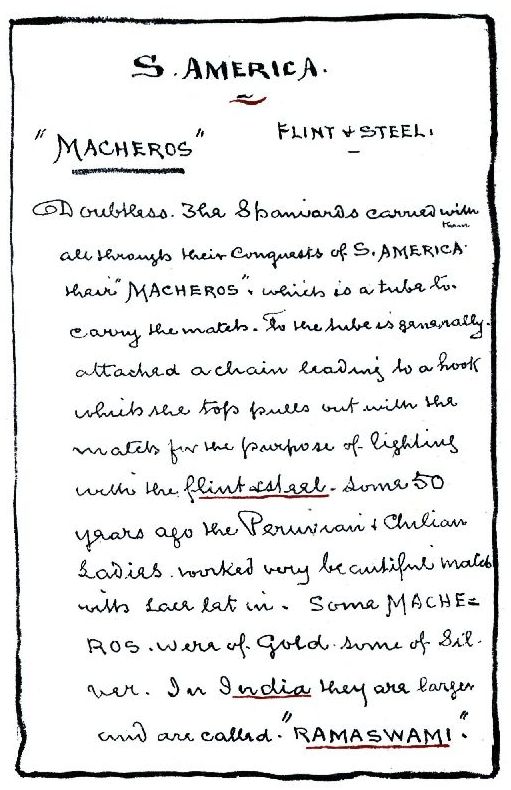
Doubtless, The Spaniards carried with them all through their Conquests of S. AMERICA their “MACHEROS” which is a tube to carry the match. To the tube is generally attached a chain leading to a hook which the top pulls out with the match for the purpose of lighting with the flint & steel. Some 50 years ago the Peruvian & Chilian Ladies worked very beautiful match with Lace let in. Some MACHEROS were of Gold, some of Silver. In India they are larger and are called “RAMASWAMI.”
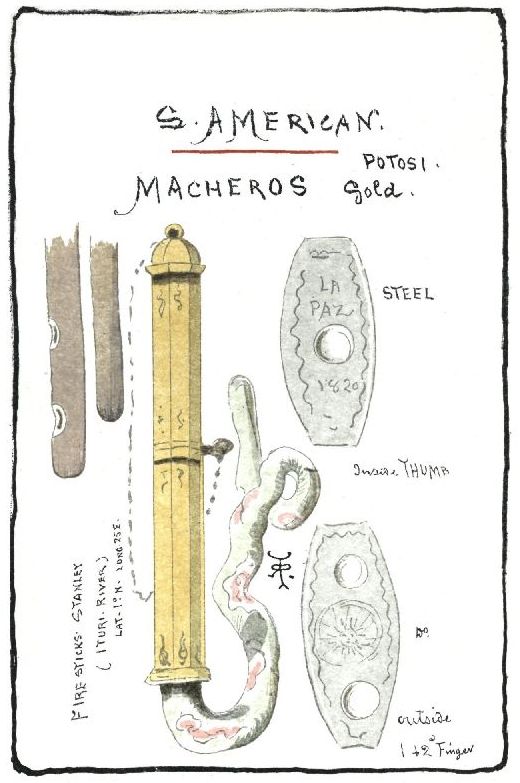
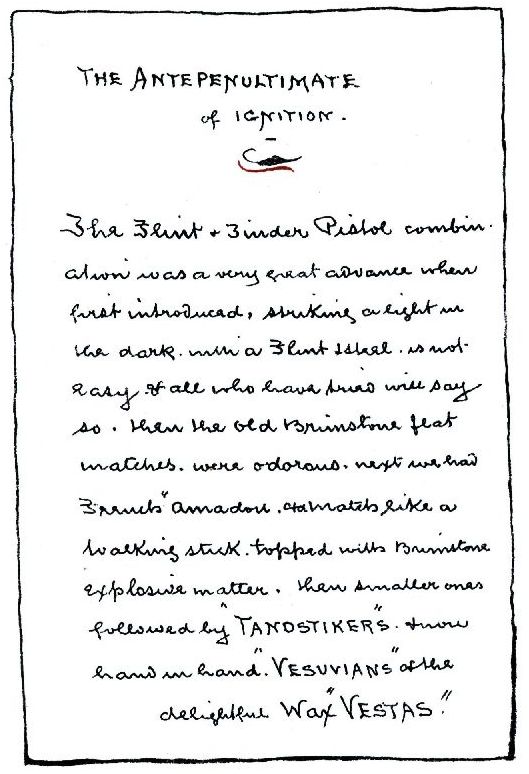
The Flint & Tinder Pistol combination was a very great advance when first introduced, striking a light in the dark with a Flint & steel is not easy & all who have tried will say so, then the old Brimstone flat matches were odorous, next we had French “Amadou” & a match like a walking stick topped with Brimstone explosive matter, then smaller ones followed by “TANDSTIKERS” & now hand in hand “VESUVIANS” of the delightful Wax “VESTAS.”
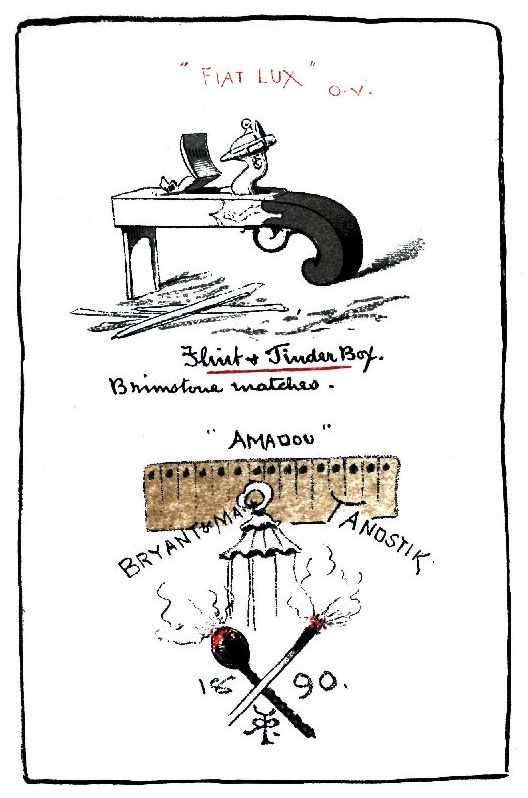
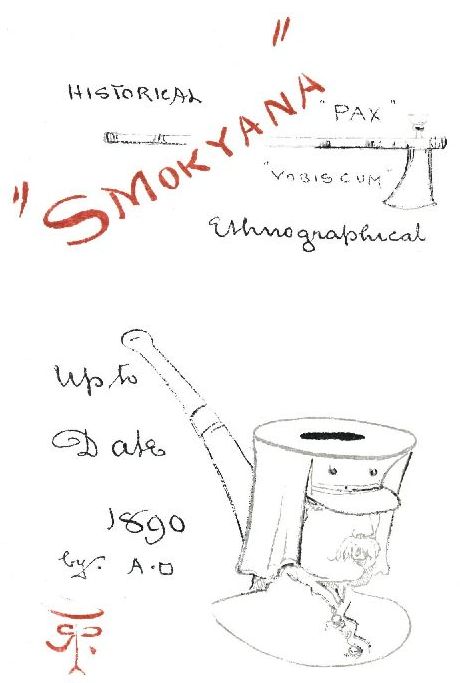
Very few edits were made to this book with the exception of trying to remove what seemed to be editing dots vs. actual periods, fullstops, commas and em-dashes, and adding quotation marks now and then to balance them. Ellipses are two .. in this text. The remaining changes are listed below.
Page 32, repeated word “of” removed from text. Original read (cruel scenes of of useless)
Page 64, “mixturr” changed to “mixture” (this case a mixture)
Page 90, “he” changed to “the” (years ago to the)